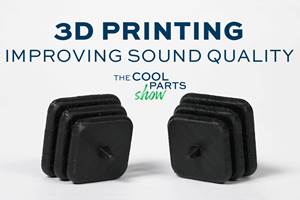Materialise’s Translucent Material Expands Eyewear Design Capabilities
The company opens up new design possibilities with the fusion of 3D printing and translucent material.
Materialise has expanded its material portfolio with a translucent material for creating 3D printed eyewear. This addition to Materialise's portfolio enables eyewear manufacturers to merge the design advantages of 3D printing with consumer demand for translucent eyewear collections. The company says the introduction of this material opens the door to visually compelling collections that will shape the future of eyewear fashion.
As eyewear manufacturers embraced 3D printing for its exceptional design capabilities, they often encountered a practical limitation: the technology couldn't replicate the translucent aesthetics traditionally associated with acetate frames. The introduction of a new translucent material empowers eyewear brands to blend translucency with the design flexibility of 3D printing, enabling designers to move beyond what is possible with acetate.
The translucent material is the result of five years of extensive trialing of over 50 different materials against the gold standard of established eyewear materials, including tests for biocompatibility, thermal resilience and impact resistance.
“The convergence of 3D printing technology with the advent of innovative translucent materials opens up a realm of exhilarating design possibilities for eyewear designers,” says Alireza Parandian, head of global business strategy, wearables at Materialise. “In the past decade, 3D printing has introduced a new level of freedom that offers designers unlimited creativity to craft intricate and customized frames. Moving forward, the introduction of translucent materials to the 3D printing palette will bring a new dimension to eyewear aesthetics. These materials, with their ethereal qualities, transform eyeglass frames into works of art, offering a unique interplay of complexity and depth.”
3D printing can offer multiple advantages for manufacturing eyewear, including shorter development cycles, faster routes to market and sustainable credentials. It also enables designers to experiment with form — offering the ability to play with complex shapes, intricate structures and textures that are impossible to replicate with traditional production techniques. Over the last decade, this has led to the widespread adoption of 3D printed eyewear across the industry.
The company says this marriage of technology and material innovation promises to redefine the future of eyewear design, offering designers a diverse array of new options to enhance both their vision and style.
- Learn about Materialise’s efforts in the medical field after it opened a medical 3D printing facility in Plymouth, Michigan. There, the company specializes in the 3D printing of personalized titanium cranio-maxillofacial (CMF) implants for more patient-specific care.
- Materialise is also working in aerospace as it partners with GKN Aerospace to propel additive manufacturing in aviation. Materialise supported the delivery of the additively manufactured wing tip for Eviation’s Alice, the world's largest all-electric aircraft, which made its maiden flight in 2022.
Related Content
3D Printed Ductile Spikes for Better Sound Quality: The Cool Parts Show Bonus
Work on 3D printing flexible metal bellows has led to other applications, including the development of ductile spikes that sit between a speaker and the surface below to help limit vibration and isolate the audio equipment.
Read MoreHow Production Looks Different for 3D Printed Furniture Manufacturer Four Years Later: AM Radio #50
Furniture manufacturer Model No. has shown that there is a demand for customizable, sustainable 3D printed tables, chairs and more since we last covered the company in 2020. But today, production looks different.
Read MoreWhy Customization at Mass-Market Scale Is Finally Possible With 3D Printing
Printer speed and materials coupled with scanning technologies are contributing to more affordable and accessible 3D printed, personalized goods.
Read MoreItalian Furniture Maker Uses WASP Technology to Create 3D Printed Pendant Lamps
The versatility of 3D printed ceramic enabled the designers to shape a weave reminiscent of the beehive concept, enhanced by the light source.
Read MoreRead Next
Bike Manufacturer Uses Additive Manufacturing to Create Lighter, More Complex, Customized Parts
Titanium bike frame manufacturer Hanglun Technology mixes precision casting with 3D printing to create bikes that offer increased speed and reduced turbulence during long-distance rides, offering a smoother, faster and more efficient cycling experience.
Read MoreAlquist 3D Looks Toward a Carbon-Sequestering Future with 3D Printed Infrastructure
The Colorado startup aims to reduce the carbon footprint of new buildings, homes and city infrastructure with robotic 3D printing and a specialized geopolymer material.
Read MorePostprocessing Steps and Costs for Metal 3D Printing
When your metal part is done 3D printing, you just pull it out of the machine and start using it, right? Not exactly.
Read More





















